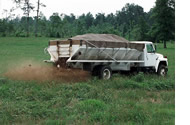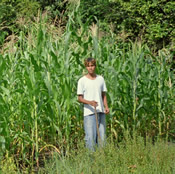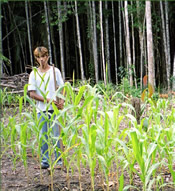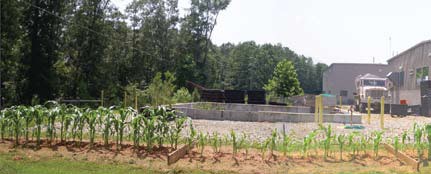Biochar Enhances Crop Yield, Enriches Soil & Protects Water
Why Biochar?— Amending Soil with biochar is modeled after a process begun thousands of years ago in the Amazon Basin, where islands of rich, fertile soils called terra preta (dark earth) were created by indigenous people. Anthropologists speculate that cooking fires and kitchen debris along with deliberate placing of charcoal in the ground resulted in soils with high fertility and carbon content. These soils continue to "hold" carbon today and remain so nutrient rich that they have been dug up and sold as potting soil in Brazilian markets.
Soil's Best Friend— Because of biochar's physical and chemical nature, it has a unique ability for attracting and holding moisture, nutrients, and agrochemicals even retaining difficult to hold nutrients like nitrogen and phosphorous. Nitrogen tends to run-off regular soils, upsetting ecosystem balance in streams and riparian areas. Biochar also holds gasses; recent research has proven biochar-enriched soils reduce carbon dioxide (CO2) and nitrous oxide (N2O) emissions by 50-80%. N2O is a significant greenhouse gas, 310 times more potent than CO2.
 Biochar's immense surface area and complex pore structure (a single gram can have a surface area of over 1000 square yards) provides a secure habitat for micro-organisms and fungi. Certain fungi form a symbiotic relationship with plant root fibers and this allows for greater nutrient uptake by plants. There is speculation that this fungi may play a part in terra preta's ability to regenerate itself.
Biochar's immense surface area and complex pore structure (a single gram can have a surface area of over 1000 square yards) provides a secure habitat for micro-organisms and fungi. Certain fungi form a symbiotic relationship with plant root fibers and this allows for greater nutrient uptake by plants. There is speculation that this fungi may play a part in terra preta's ability to regenerate itself.
Persistency in Soil— It is undisputed that biochar is more persistent than any form of organic matter commonly applied to soil. Because of biochar's long-term persistence in soil (more than 2,500 years and counting), all the associated benefits of nutrient retention, water retention and overall soil fertility are longer lasting than with common fertilizers alone. Biochar, comparatively inert, doesn't break down like other organic soil amendments and resists chemical and microbial degradation, especially when buried.
 Biochar reduces soil acidity decreasing liming needs but does not actually add nutrients. Biochar made from manure is the exception; it retains a significant amount of nutrients from its source. Because biochar attracts and holds soil nutrients, it reduces fertilizer requirements - something common organic matter cannot do. As a result, fertilization costs are minimized and fertilizer (organic or chemical) is retained in the soil for far longer. Chemical fertilizers are typically fossil-fuel based, thus biochar provides additional indirect climate change benefits by reducing fertilizer needs.
Biochar reduces soil acidity decreasing liming needs but does not actually add nutrients. Biochar made from manure is the exception; it retains a significant amount of nutrients from its source. Because biochar attracts and holds soil nutrients, it reduces fertilizer requirements - something common organic matter cannot do. As a result, fertilization costs are minimized and fertilizer (organic or chemical) is retained in the soil for far longer. Chemical fertilizers are typically fossil-fuel based, thus biochar provides additional indirect climate change benefits by reducing fertilizer needs.

 Enhanced Crop Yields— When added to soil, biochar improves plant growth and enhances crop yields, increasing food production and sustainability in areas with depleted soils, limited organic resources, insufficient water and/or access to agrochemical fertilizers. Not all soils react the same to biochar and it frequently can take up to a year to see results. On poor soils with low carbon content, many studies have shown biochar can increase crop yields up to four times, like the corn plots pictured on the right and below.
Enhanced Crop Yields— When added to soil, biochar improves plant growth and enhances crop yields, increasing food production and sustainability in areas with depleted soils, limited organic resources, insufficient water and/or access to agrochemical fertilizers. Not all soils react the same to biochar and it frequently can take up to a year to see results. On poor soils with low carbon content, many studies have shown biochar can increase crop yields up to four times, like the corn plots pictured on the right and below.

Research presented at a recent American Chemical Society annual meeting suggests that biochar plus chemical fertilizer yields increased growth of winter wheat and several vegetables by 25-50% compared to chemical fertilization alone. Soil Science Society of America experiments found that biochar supplemented with fertilizer outperformed fertilizer alone by 60%.
It is important to note that not all biochar is the same. The key chemical and physical properties of biochar are greatly affected by the type of feed stock being heated and the conditions of the pyrolysis process. For example, biochar made from manure will have a higher nutrient content than biochar made from wood cuttings. However, the biochar from the wood cuttings is likely to have a greater degree of persistence over a longer period of time. The two different chars will look the same but will behave quite differently.
Click here for a printer friendly version.
Other useful Fact Sheets include:
- Guidelines for Crop Applications: https://biochar-us.org/biochar-crop-application-guidelines
- Guildeline for Crop Applications (Espanol): https://biochar-us.org/biochar-crop-application-guidelines-espanol
- NRCS US Funding Guideline: https://biochar-us.org/usda-nrcs-biochar-funding-quick-guide
- Plant Survival: https://biochar-us.org/biochar-increases-plant-survival
- Compost benefits: https://biochar-us.org/fact-sheet-biochar-compost
- Manure management: https://biochar-us.org/biochar-improves-manure-management
- Stormwater management: https://biochar-us.org/stormwater-management
- Carbon Markets: https://biochar-us.org/carbon-markets-fact-sheet
Sign up for the USBI monthly newsletter here: https://biochar-us.org/newsletter-signup